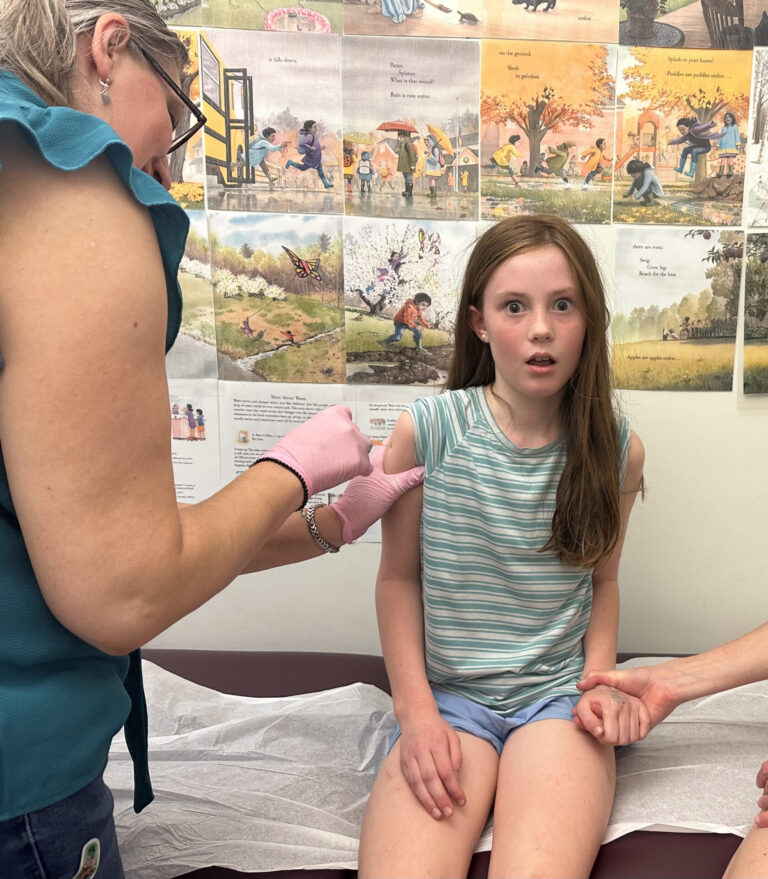Corona with Lyme – the Ticks are Ba-ack!
Posted on April 20th, 2020 to Uncategorized
Since global warming Jerseyfied our winter, the ticks are out early and they’re hungry. In 2017 Vermont had the nation’s highest rate of Lyme disease. Moreover, boys aged 5-14 years were most likely to contract Lyme disease. Let’s review tick bites, lyme disease, and our office’s approach.
Lyme disease is caused by a spirochetal bacteria called Borrelia burgdorferi that resides in the Ixodes scapularis (black-legged, or deer) tick’s stomach. Lyme disease is caused by the immune system’s brisk reaction to the spirochete as it burrows through the body’s tissues. The host animals for Lyme disease are small mammals (not deer) that the ticks feed on. More than half of the Ixodes scapularis ticks in Vermont carry Lyme disease.
There are 6 different Lyme disease-carrying species of the bacteria genus Borrelia, the most common of which is Borrelia burgdorferi. Additionally there are 10-15 strains of B. burgdorferi. This means that one can contract Lyme disease multiple times. Therefore prevention is the most important defense against Lyme disease.
The most important preventive measure is to get into the routine of nightly tick checks. Wearing pants with socks tucked over the cuffs, treating clothing with permethrin, and wearing 20% DEET on the legs are also good ideas. In 1998 an immunization called Lymerix was developed. However, it was removed from the market after an unfounded claim that it may cause autoimmune arthritis made it financially unviable.
It isn’t until the tick has fed to full engorgement that the spirochetes migrate out of the crowded stomach, into the salivary glands. It takes about 48 hours of being attached for a tick to transmit Lyme disease.
There is only a 1% incidence of Lyme disease if ticks are attached less than 72 hours. If the tick is attached greater than 72 hours the incidence of Lyme disease is 20-25%. So, how do you know how long a tick has been attached? If a tick is engorged it has been attached at least 24 hours.
We will give children a prophylactic single dose of the antibiotic doxycycline for a tick bite in which the tick is engorged, and it has been less than 72 hours since the discovery of the tick. This has a very slight effect on decreasing the development of Lyme disease – in adults you’d need to treat 40-250 people to prevent one case of Lyme disease.
The diagnosis of Lyme disease is made clinically, not by lab confirmation. The only reliable testing for Lyme disease is a two-step process looking for antibodies to Lyme disease. We don’t often do this testing because it doesn’t usually help with management. It takes about 6 weeks for Immunoglobulin G antibodies to form against Lyme disease, and they last a long time. Treatment shouldn’t wait for 6 weeks. Moreover, a positive test doesn’t distinguish whether the infection is current or from the distant past. We do not advise testing of the tick for Lyme disease. If the tick is positive, it does not mean it transmitted Lyme disease.
An erythema migrans rash (bullseye or ring-shaped red spot that is often 5 cm or larger and often at the site of the bite within 2 weeks of the bite) is present 80% of the time that Lyme disease develops. Most of the time that an erythema migrans rash is found, there is no known history of a tick bite – the tick was on long enough to transmit Lyme, it fed to completion, then dropped off.
In addition to an erythema migrans rash, symptoms of Early Localized Lyme disease include fever, fatigue, headache, muscle aches, joint aches and swollen lymph nodes. When treated in the Early Localized stage, eradication of Lyme is achieved more than 90% of time. Treatment is 10-21 days of doxycycline.
Late Disseminated Lyme disease can include flu-like symptoms, fever, fatigue, multiple ring-shaped lesions, Bell’s palsy (facial paralysis), swollen joints, a markedly slowed heart rate, meningitis, among other symptoms. The treatment at this stage is symptom dependent but is also antibiotics.
Up to 15% of people with treated Lyme disease will develop Post-Lyme Disease Syndrome. This is not caused by persistent infection. It is characterized by headaches, fatigue and joint pains that always resolve within 6 months.
PLDS is different from the proposed entity Chronic Lyme Disease, which has similar symptoms but lasts longer. There is no Western medicine evidence to support this condition. Many of the people who report Chronic Lyme Disease actually have another medical problem to explain the symptoms. We sympathize with people who suffer the symptoms of CLD and encourage them to seek medical attention.
When Lyme disease symptoms are worse than normal, or aren’t responding to treatment as quickly as would be expected, it may be due to co-infection with another tick-borne disease, which happens 15% of the time. In Vermont we have Babesiosis, Anaplasmosis, Erlichiosis, Tularemia, and Powassan virus. Most of these are also treated with doxycycline, so they may be treated unintentionally when we diagnose Lyme disease.
The potential for Lyme disease and other tick-borne illnesses to have serious consequences is scary. We don’t have good testing for it. We have good treatment, and effective prevention strategies. Being outside is critical for our mental wellness. Go out there and teach your kids to love nature. Also, teach them to check for ticks every night.
References:
UpToDate
CDC
AAP – Red Book



